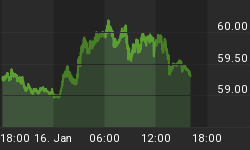There are many funny stories out about disinflation these days. The meme has gotten amazing momentum, even more than it usually does at this time of year (see my post last month, "Seasonal Allergies"). One of the most amusing has been the idea that the decision by the Bank of Japan to greatly increase its quantitative easing would be disinflationary in the U.S., because the yen would decline so sharply against the dollar, and dollar strength is generally assumed to be disinflationary.
The misunderstanding of the dollar effect is amazing, considering how easy it is to disprove. Sure, I understand the alarm at the dollar's recent robust strength. Of course, such a large and rapid move must be disinflationary, right? Because who could forget the inflationary spiral of 2002-2008 in this country, when the value of the dollar fell 25%?
For the record, when the dollar hit its high in February 2002, core inflation was at 2.6%. It declined to 1.1% in 2003, before rebounding to 2.9% in 2006 and was at 2.3% in April 2008, when the dollar reached its pre-crisis low. That is, the dollar's protracted and large decline caused essentially no meaningful change in core inflation. Indeed, without the housing bubble, core inflation would have declined markedly over this period.
Now, headline inflation rose during that period, because energy prices rose. This may or may not be the result of the dollar, or the causality may run at least partly the other way (because the dollar was cheaper, and oil is priced in dollars, oil got comparatively cheaper in foreign currencies, leading to greater demand). But what is very clear is that the underlying rate of inflation was not impacted by the dollar.
The bifurcation of inflation into core inflation and energy inflation (or food and energy inflation, if you like, but most of the volatility comes from energy inflation) is a critical point for both investors and policymakers. Much ink has recently been spilled about how the Saudi decision to lower the price of oil to better compete with U.S. shale supply, and the burgeoning shale supply itself, is disinflationary. But it isn't, and it is important to understand why. Inflation is a rate of change measure, and more to the point a change in prices is not inflation per se unless it is persistent. Policymakers don't focus on core inflation because they don't care about food or energy or think that we don't buy them; they focus on core inflation because it is more persistent than food or energy inflation.
So if gasoline prices aren't merely in their usual seasonal dip, but actually continue lower for another year, it will result in headline inflation that is lower than core inflation over that period. But once it reaches a new equilibrium level, that downward pressure on headline inflation will abate, and it will re-converge with core.
Oil prices, in fact, are almost always a growth story rather than an inflation story, and some of the big monetary policy crack-ups of the past have occurred when the Fed addressed oil price spikes (plunges) with tighter (looser) monetary policy. In fact, if any policy response is warranted it would probably be the opposite of this, since higher oil prices cause slower broad economic growth and lower oil prices cause faster broad economic growth. (However, long time readers will know that I don't believe monetary policy can affect growth significantly anyway.)
Back, briefly, to the BOJ balance sheet expansion story. This was a very significant event for global inflation, assuming as always that the body follows through with their stated intention. Money printing anywhere causes the equilibrium level of nominal prices globally to rise. To the extent that this inflation is to be felt idiosyncratically only in Japan, then the decline of the currency will offset the effect of this global increase in prices so that ex-Japan prices are steady while prices in Japan rise...which is the BOJ's stated intent. Movements in foreign exchange are best understood as allocating global inflation between trading partners. However, for money-printing in Japan to lead to disinflation ex-Japan, the movement in the currency would have to over-react to the money printing. If markets are perfectly efficient, in other words, the movement in currency should cause the BOJ's idiosyncratic actions to be felt only within Japan. There are arbitrage opportunities otherwise (although it is very slow and risky arbitrage - better thought of as arbitrage in an economic sense than in a trading sense).
Of course, if the BOJ money-printing is not idiosyncratic - if other central banks are also printing - then prices should rise around the world and currencies shouldn't move. This is why the Fed was able to get away with increasing M2 significantly without cratering the dollar: everyone was doing it. What is interesting is that the global price level has not yet fully reflected the rise in the global money supply, because of the decline in global money velocity (which is due in turn to the decline in global interest rates). This is the story that is currently being written, and will be the big story of the next few years.

















